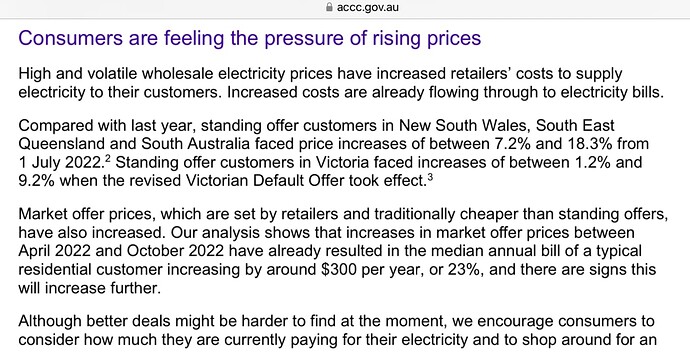The ACCC regularly reports, as does the AER on the Australian electricity market. The latest review was current up to Q3 2022. It includes informed commentary on how the market performed (conditions), and regulatory responses to the higher than usual FF costs, demand increases and generation failures over the preceding 12 months.
It’s a long read and detailed with technical/commercial. The Executive Summary and Recommendations (first 6 pages only) may be the most productive read.
Of note were the actions of the AEMO to cap spot prices for a period of time, as well as make directions to the generators to ensure supply.
On Pricing -
Some of the electricity volume purchased by the retailers is contracted in advance at fixed prices. Additional needs are typically purchased through the regulated spot market. The risks of volatility in the spot market are most often managed through a third party and hedging contracts. For the average consumers this may not mean very much, but is very relevant in understanding.
It is not uncommon for the media to grab short sound bites, considering the spot prices are recontested in 5 minute blocks 12 times every hour. They can be relatively very high when demand peaks (typically in the evening) and fall to low, zero or negative prices in the middle of the day.
Neither extreme is truely reflective of the long term average. They ignore the averaging influence of the fixed supply contracts and hedging. More frequent and prolonged high spot prices are indicative of the trend towards higher costs for consumers, but not to the extreme of the spot prices used for headlines. It is fact that prices have gone up significantly, depending on where one resides.
The ACCC moved to look closely at the hedging contracts and long term supply agreements entered into by the retailers for the wholesale market. The relevance is best explained by the ACCC.
The role of the ACCC and it’s appointed regulator AER is independent of government. Individual consumer outcomes for energy pricing are further influenced by differences in the approaches taken by each state or territory government. All have made decisions independent of each other on transitioning to renewables and the level of involvement/retention of assets in their respective markets.
While energy costs have taken off, detailed discussion may need to qualify which state or territory the circumstances or content relates to, and possibly which distribution area.
EG QLD regulates directly consumer tariffs where Ergon is the distributor, outside the SE corner of the state. It also retains ownership of the other distributor Energex and the transmission assets, as well as a significant generation capacity. Two different outcomes within the one state!


